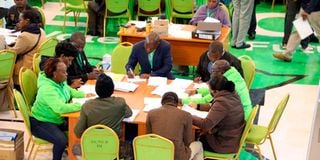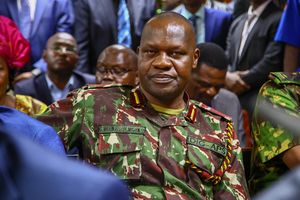Media training should include informatics bit

Observers and party agents at Bomas of Kenya on August 13, 2022. Journalists have been struggling to add up the numbers in an effort to tell their stories.
What you need to know:
- Journalists have been struggling to add up the numbers in an effort to tell their stories.
- Media practitioners seemed to face challenges with the addition, ending up as part of the election story.
- Journalists in Kenya learnt a big lesson—that telling news and feature stories using numbers is a must.
Ever since the August 9 General Election, evidence has been emerging of little understanding, among Kenyans, of basic figures—mathematics, or simple arithmetic—which do not seem to add up.
Everybody was keen to follow the IEBC-generated results of the presidential election streaming on media channels as votes were counted and tallied.
Equally, journalists have been struggling to add up the numbers in an effort to tell their stories by not only reporting on the happenings but also investigating why events took such courses.
However, media practitioners seemed to face challenges with the addition, ending up as part of the election story.
Tallying votes is not storytelling. It became clear that journalists had to learn and master the language of figures and their significance.
“Chereromatics” and “Cher-error” were coined and quickly came into vogue.
Attributed to critics of the vice-chairperson Juliana Cherera-led quartet of dissenting IEBC commissioners, this was a new term insofar as informatics studies are concerned and as part of information sciences, which is critical in pursuing journalism at the university.
The Azimio coalition cited in its petition at the Supreme Court “inconsistency” in IEBC’s vote figures, declared turnout numbers and the undeclared skeletons in the falling-out in the commission.
IEBC chairperson Wafula Chebukati initially reported a 65.4 per cent turnout or 14,466,779 voters.
But, at 14,326,751, his final tally was 140,028 votes less—besides those who voted manually.
Some say the spoilt ballots could not be accounted for. IEBC was split down the middle: The Chebukati and Cherera factions had three and four members, respectively.
Analysts opined that the Cherera-led “Opaque 4” couldn’t get their math right.
Mathematical absurdity
They complained about a “mathematical absurdity” in the final figure announced by Chebukati but also created their own numerical absurdity.
It was, thus, not clear what they were disputing, making themselves easy prey for the media, which used the allegations to question who actually authored the statement.
Figures and data confuse journalists yet these are key in storytelling.
Reporters need a free press but if “opaqueness” was alleged by four of the seven commissioners, how free was the media at Bomas?
Were media houses banned from freely covering the vote counting, tallying and verification?
Was a journalist harassed or barred from reporting? No.
On the contrary, they actively participated in the process as witnessed by the international community, including foreign envoys and poll observers, who commented that the entire process—from political campaigns, debates and voting, up to vote verification, was free, fair and credible.
Journalists in Kenya learnt a big lesson—that telling news and feature stories using numbers is a must.
For journalists to become credible as regards figures, they must study in their syllabus and curriculum data journalism, science journalism and informatics.
Moreover, a student at the entry level must at least have a pass in mathematics before enrolling.
That would equip reporters and editors with at least the basic knowledge to skillfully articulate stories that are hidden in numbers.
Mr Kurgat teaches journalism and communication at Moi University. [email protected].




